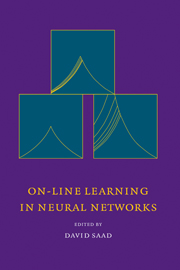Book contents
- Frontmatter
- Contents
- Acknowledgements
- List of contributors
- Foreword
- 1 Introduction
- 2 On-line Learning and Stochastic Approximations
- 3 Exact and Perturbation Solutions for the Ensemble Dynamics
- 4 A Statistical Study of On-line Learning
- 5 On-line Learning in Switching and Drifting Environments with Application to Blind Source Separation
- 6 Parameter Adaptation in Stochastic Optimization
- 7 Optimal On-line Learning in Multilayer Neural Networks
- 8 Universal Asymptotics in Committee Machines with Tree Architecture
- 9 Incorporating Curvature Information into On-line Learning
- 10 Annealed On-line Learning in Multilayer Neural Networks
- 11 On-line Learning of Prototypes and Principal Components
- 12 On-line Learning with Time-Correlated Examples
- 13 On-line Learning from Finite Training Sets
- 14 Dynamics of Supervised Learning with Restricted Training Sets
- 15 On-line Learning of a Decision Boundary with and without Queries
- 16 A Bayesian Approach to On-line Learning
- 17 Optimal Perceptron Learning: an On-line Bayesian Approach
5 - On-line Learning in Switching and Drifting Environments with Application to Blind Source Separation
Published online by Cambridge University Press: 28 January 2010
- Frontmatter
- Contents
- Acknowledgements
- List of contributors
- Foreword
- 1 Introduction
- 2 On-line Learning and Stochastic Approximations
- 3 Exact and Perturbation Solutions for the Ensemble Dynamics
- 4 A Statistical Study of On-line Learning
- 5 On-line Learning in Switching and Drifting Environments with Application to Blind Source Separation
- 6 Parameter Adaptation in Stochastic Optimization
- 7 Optimal On-line Learning in Multilayer Neural Networks
- 8 Universal Asymptotics in Committee Machines with Tree Architecture
- 9 Incorporating Curvature Information into On-line Learning
- 10 Annealed On-line Learning in Multilayer Neural Networks
- 11 On-line Learning of Prototypes and Principal Components
- 12 On-line Learning with Time-Correlated Examples
- 13 On-line Learning from Finite Training Sets
- 14 Dynamics of Supervised Learning with Restricted Training Sets
- 15 On-line Learning of a Decision Boundary with and without Queries
- 16 A Bayesian Approach to On-line Learning
- 17 Optimal Perceptron Learning: an On-line Bayesian Approach
Summary
Abstract
An adaptive on-line algorithm extending the learning of learning idea is proposed and theoretically motivated. Relying only on gradient flow information it can be applied to learning continuous functions or distributions, even when no explicit loss function is given and the Hessian is not available. Its efficiency is demonstrated for drifting and switching non-stationary blind separation tasks of accoustic signals.
Introduction
Neural networks are powerful tools that can capture the structure in data by learning. Often the batch learning paradigm is assumed, where the learner is given all training examples simultaneously and allowed to use them as often as desired. In large practical applications batch learning is experienced to be rather infeasible and instead on-line learning is employed.
In the on-line learning scenario only one example is given at a time and then discarded after learning. So it is less memory consuming and at the same time it fits well into more natural learning, where the learner receives new information at every moment and should adapt to it, without having a large memory for storing old data. Appart from easier feasibility and data handling the most important advantage of on-line learning is its ability to adapt to changing environments, a quite common scenario in industrial applications where the data distribution changes gradually over time (e.g. due to wear and tear of the machines). If the learning machine does not detect and follow the change it is impossible to learn the data properly and large generalization errors will result.
- Type
- Chapter
- Information
- On-Line Learning in Neural Networks , pp. 93 - 110Publisher: Cambridge University PressPrint publication year: 1999

